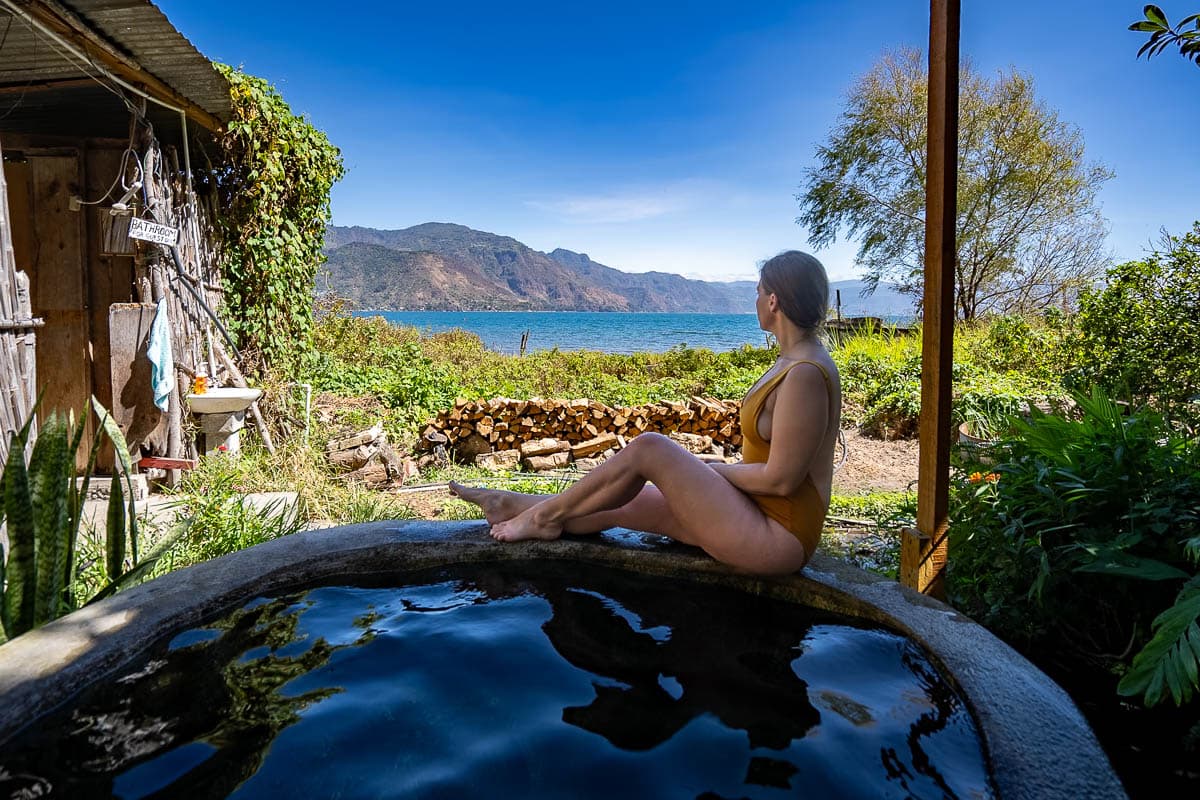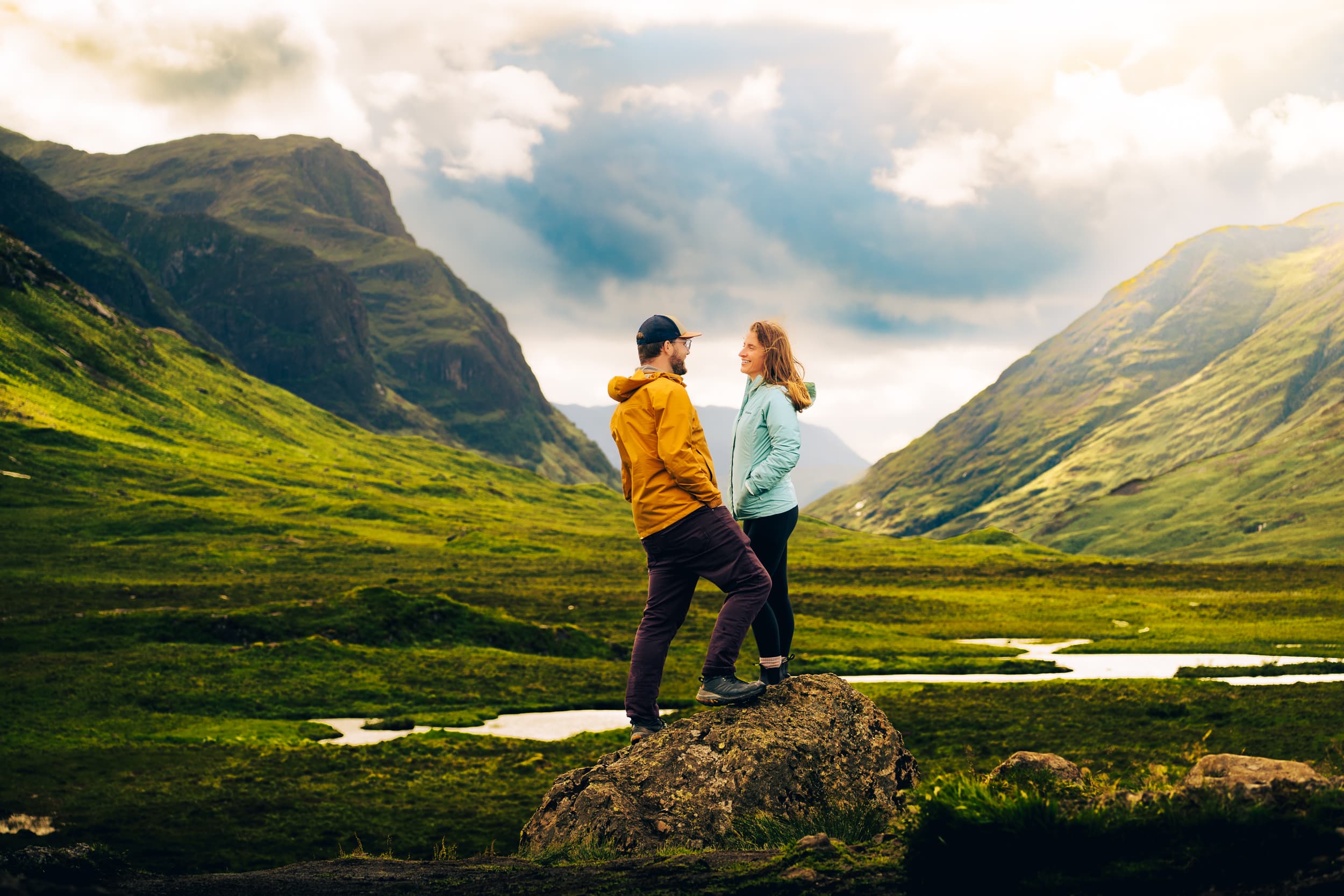Lake Atitlan is one of the most popular destinations for travelers in Guatemala, known for the 11 Mayan towns that are perched on its shores. San Pedro is one of these towns, which is renowned for its party vibes, Spanish schools, and epic volcano views.
While many people assume that San Pedro is nothing more than rowdy hostels and cheap beer, my husband, Justin, and I spent three weeks in this colorful town and discovered that it has SO much more to offer than its reputation might suggest. So if you want to get to know this magical town a bit more, here’s everything to know about San Pedro, Guatemala.
This post may contain affiliate links. If you make a purchase through them, we may receive a small commission, for which we are extremely grateful, at no extra cost to you.
Lake Atitlan is an impressive place—not only is it one of the largest bodies of water in Guatemala, but it’s also the home to a whopping three volcanoes, Atitlán, Tolimán, and San Pedro. It’s ABSOLUTELY gorgeous, with limestone cliffs, covered in lush greenery; turquoise water; and towering mountains. But, in my opinion, the most beautiful part about Atitlan is its vibrant communities, like San Pedro.
While many travelers think of San Pedro as a backpacker destination, it’s also home to 13,000 residents, primarily of Tzutujil Mayan descent; tons of excellent restaurants and cafes; and rich culture.
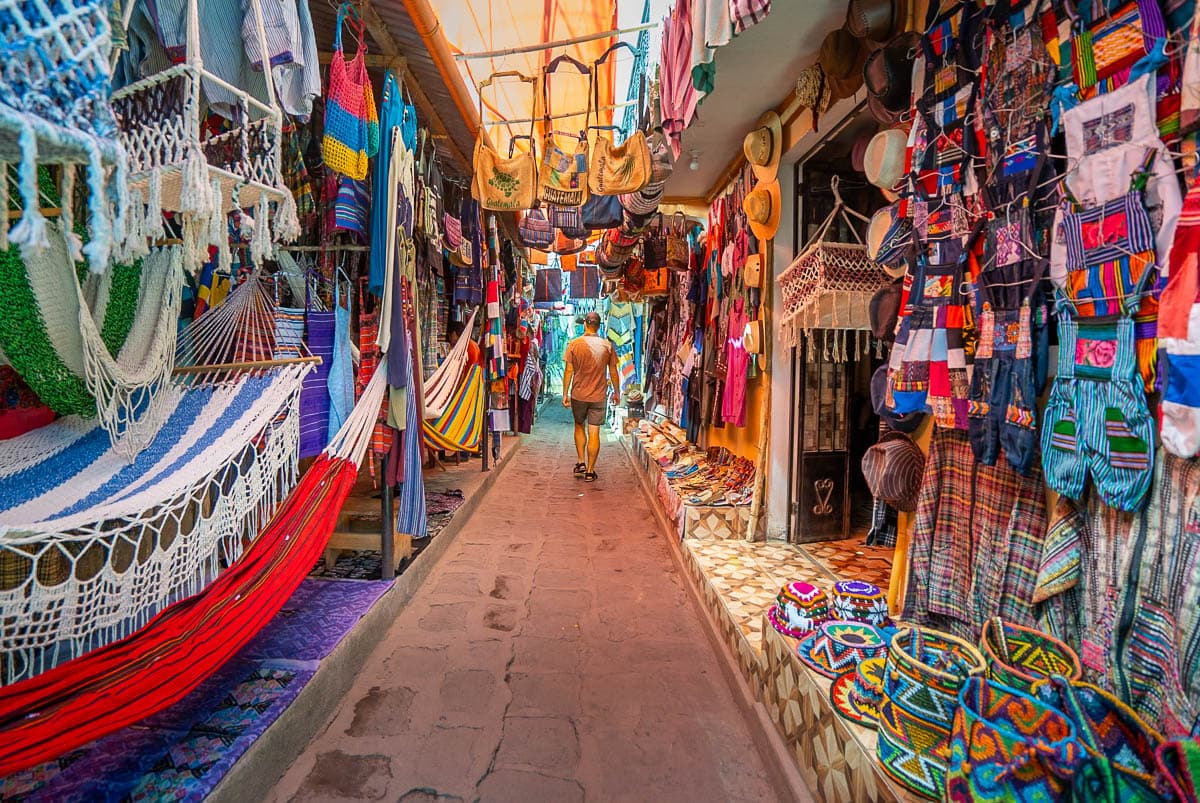
How to Get to San Pedro, Guatemala
Getting to San Pedro—and really, any of the towns in Lake Atitlan— is a teeny bit logistically challenging. Luckily, though, Lake Atitlan has long been on the well-established “backpacker trail” in Guatemala and, with tourism on the rise here, it’s never been easier to get around.
Most travelers either get to Lake Atitlan from the cities of Antigua or Guatemala City, home to the largest airport in Guatemala. If San Pedro or Antigua will be one of your first stops in Guatemala, your best bet will definitely be flying into Guatemala City.
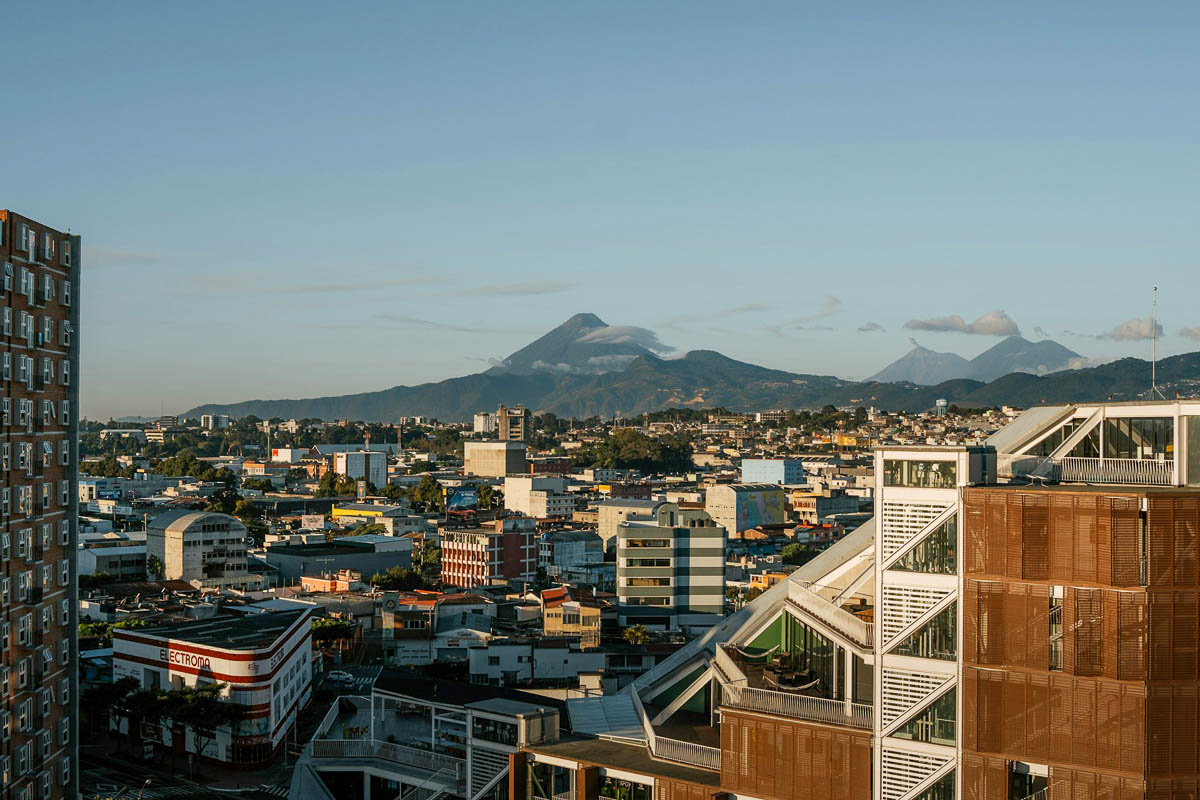
Otherwise, if you’re coming from some other area in Guatemala, like Flores or Semuc Champey, you’ll likely first need to get to either Guatemala City or Antigua in order to get transportation to the lake.
Regardless of where you’re coming from, you’ll need to first get to Panajachel (sometimes, affectionately called “Pana”), the largest city on Lake Atitlan and the only one that’s easily accessible via road.
From there, you’ll take a lancha (or boat) over to San Pedro.
Getting to Panajachel
You have a couple of options of getting to Panajachel from either Guatemala City or Antigua.
Shuttles
Most visitors generally take a shuttle to Panajachel, given it’s the easiest, quickest, and most convenient method of transit.
Most shuttles will pick you up directly from your hotel or from the airport, if you’re in Guatemala City, and they tend to have less issues with petty theft from luggage than public transit options. Of course, you’ll pay a bit more for these shuttles than public transit, usually somewhere between $30-40 USD.
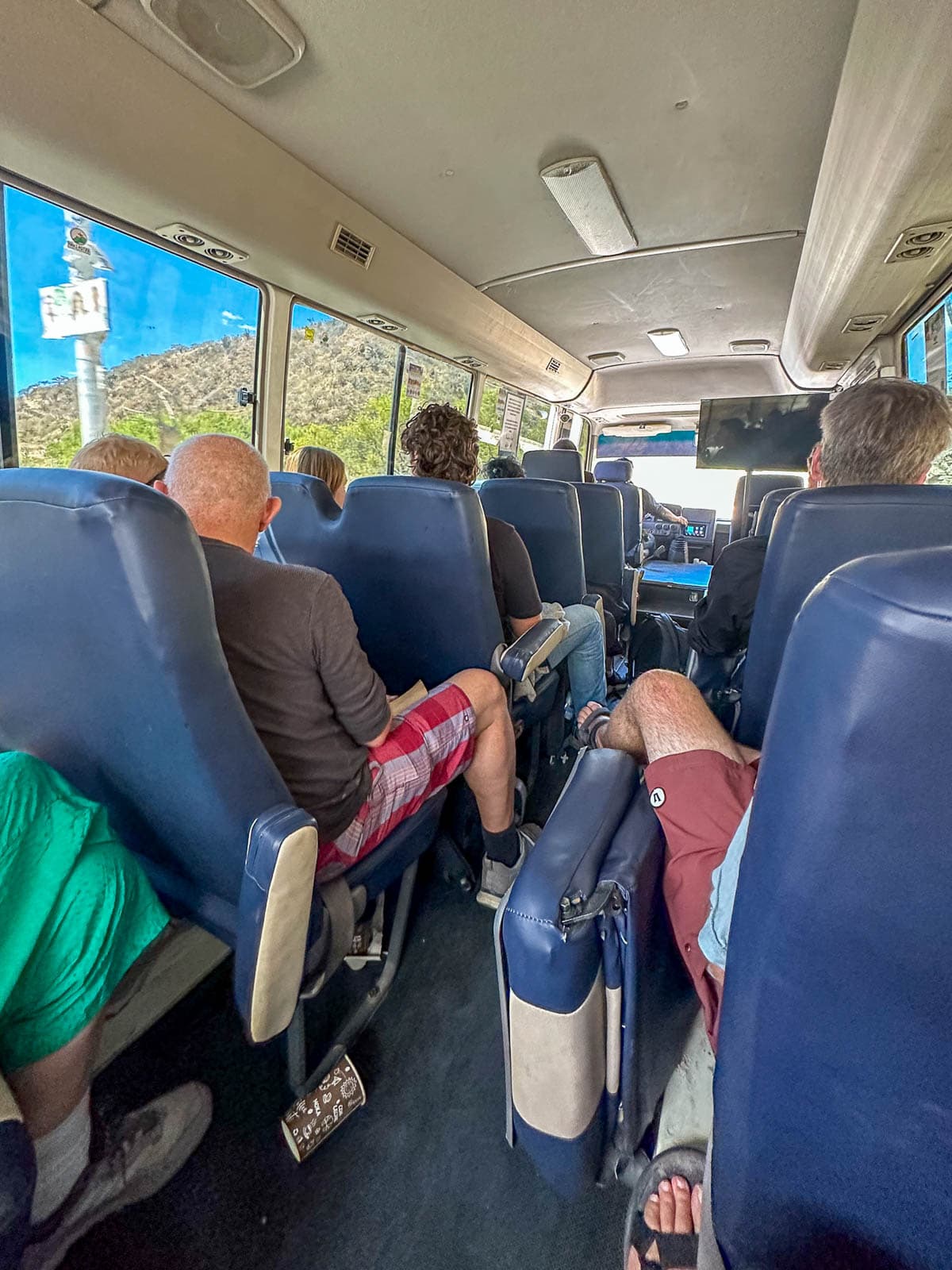
Shuttle options from Guatemala City
Shuttle options from Antigua
Chicken bus
If you’re on a budget and speak a decent amount of Spanish, you could alternatively take a chicken bus to Panajachel. If you’re unfamiliar with chicken buses, they’re basically decommissioned school buses that have been souped up with bright colors and patterns and repurposed into standard transit buses.
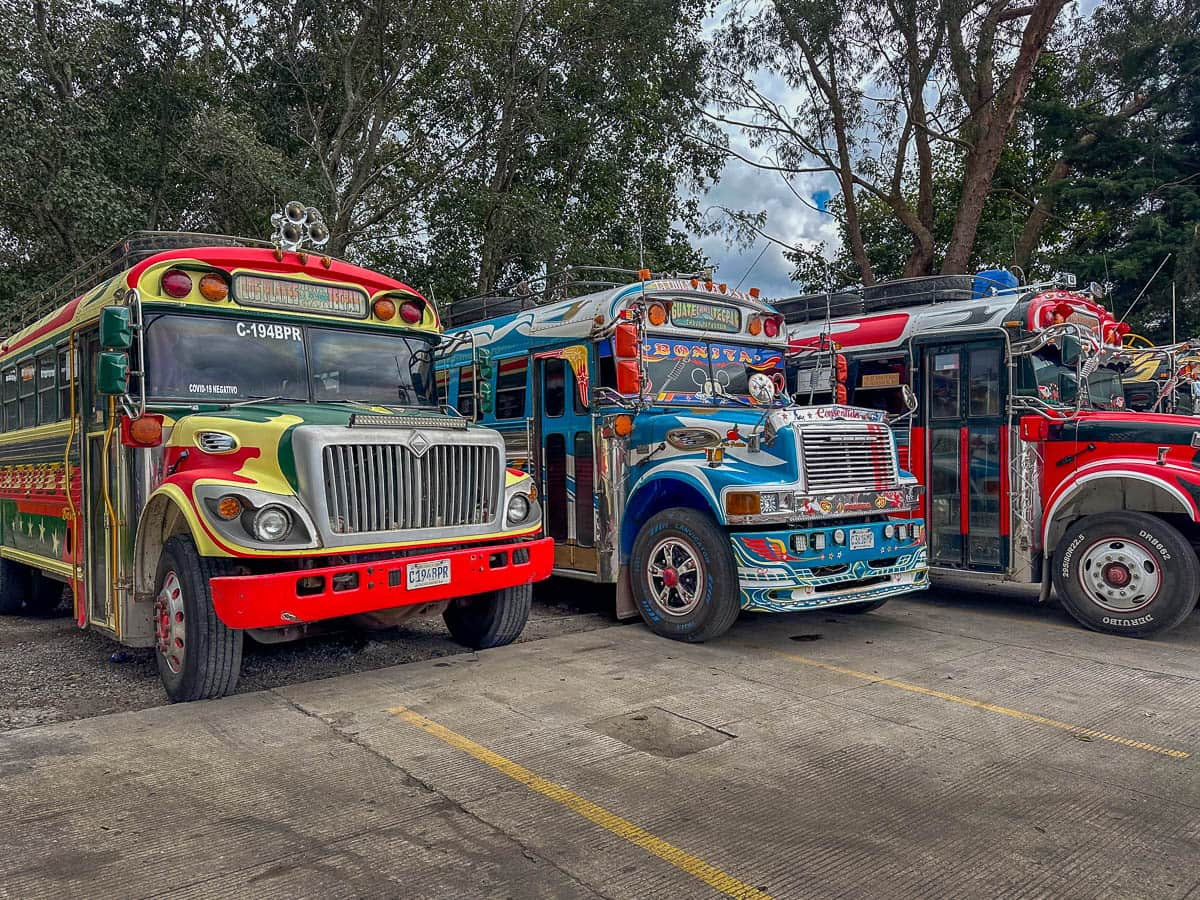
I’d only recommend this option if you’re more of an *adventurous* traveler—the buses are usually packed to the brim with people, they don’t have air conditioning, and they’re typically quite long, given there’s usually lots of stops along the way.
Plus, they’re not exactly known for being the safest—pickpocketing is extremely common and there are actually several governments, including the United Kingdom, that advise tourists against riding on them.
Still, if you’re on a budget and like having more authentic experiences, you can get to Pana for under $10!
Chicken buses from Guatemala City
There’s one bus company, Transportes REBULI, that offers a daily bus service that stops in Panajachel.
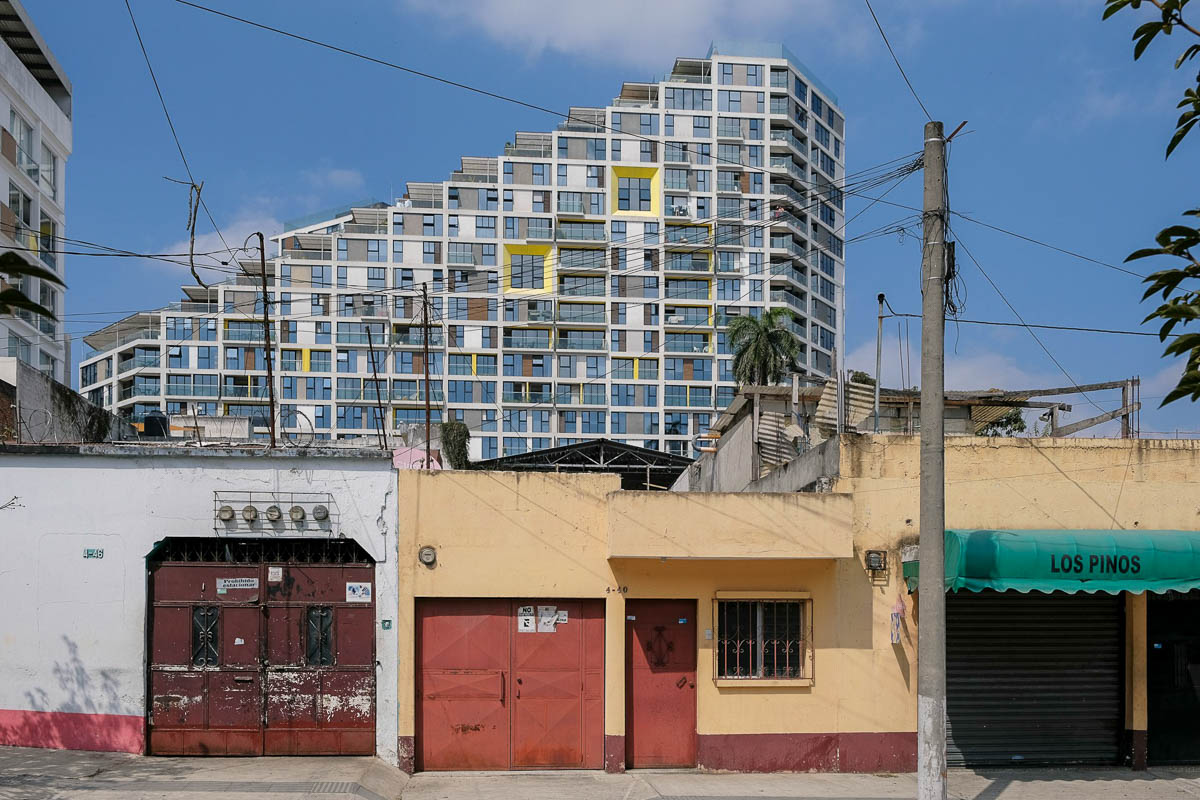
You can get tickets for this service from the company’s office in Zone 1. These buses are supposed to leave once every hour, but it’s not the most reliable service and can sometimes only depart once every four hours. Accordingly, I’d only take this route if you’ve got a chill outlook and plenty of time to burn.
Chicken buses from Antigua
The best way to catch a chicken bus in Antigua to Panajachel is from this bus terminal, where you’ll want to catch one that’s headed to the town of Chimaltenango. As far as I’m aware, there isn’t a specific company that offers this—you’ll just need to just chat with the drivers at the Antigua bus terminal.
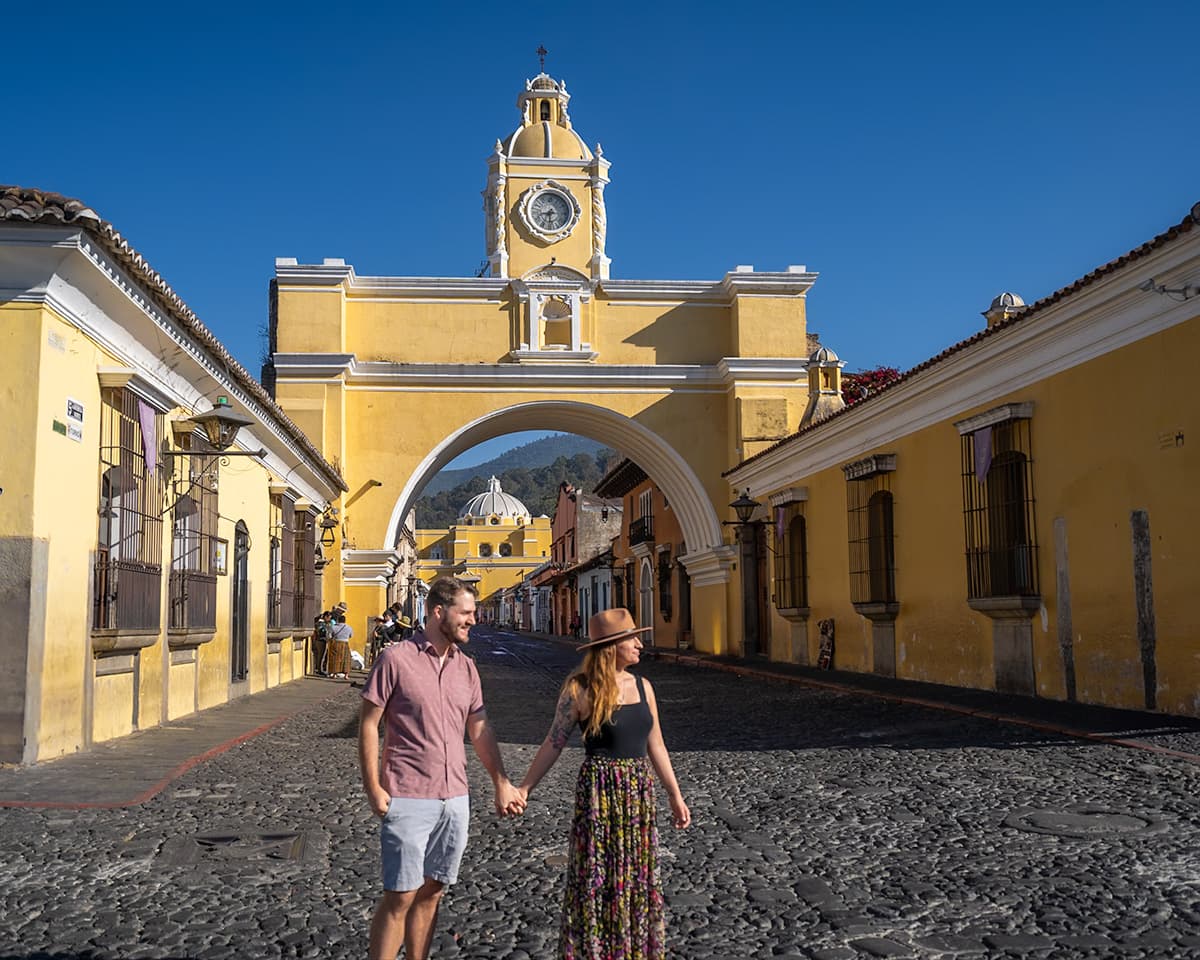
From here, you’ll need to catch another chicken bus that will actually take you all the way to San Pedro (not Pana).
Taxi
Theoretically, you could get to San Pedro by taxi from Guatemala City or Antigua. This is the most expensive way to get there—usually at least $130 from either city—but it might make sense if you have a larger group to split the cost with.
I’d recommend booking a taxi online ahead of time or directly through your hotel. Ubers in Guatemala are safe, but I suspect you’d have a difficult time finding a driver that would be willing to take you all the way to Pana.
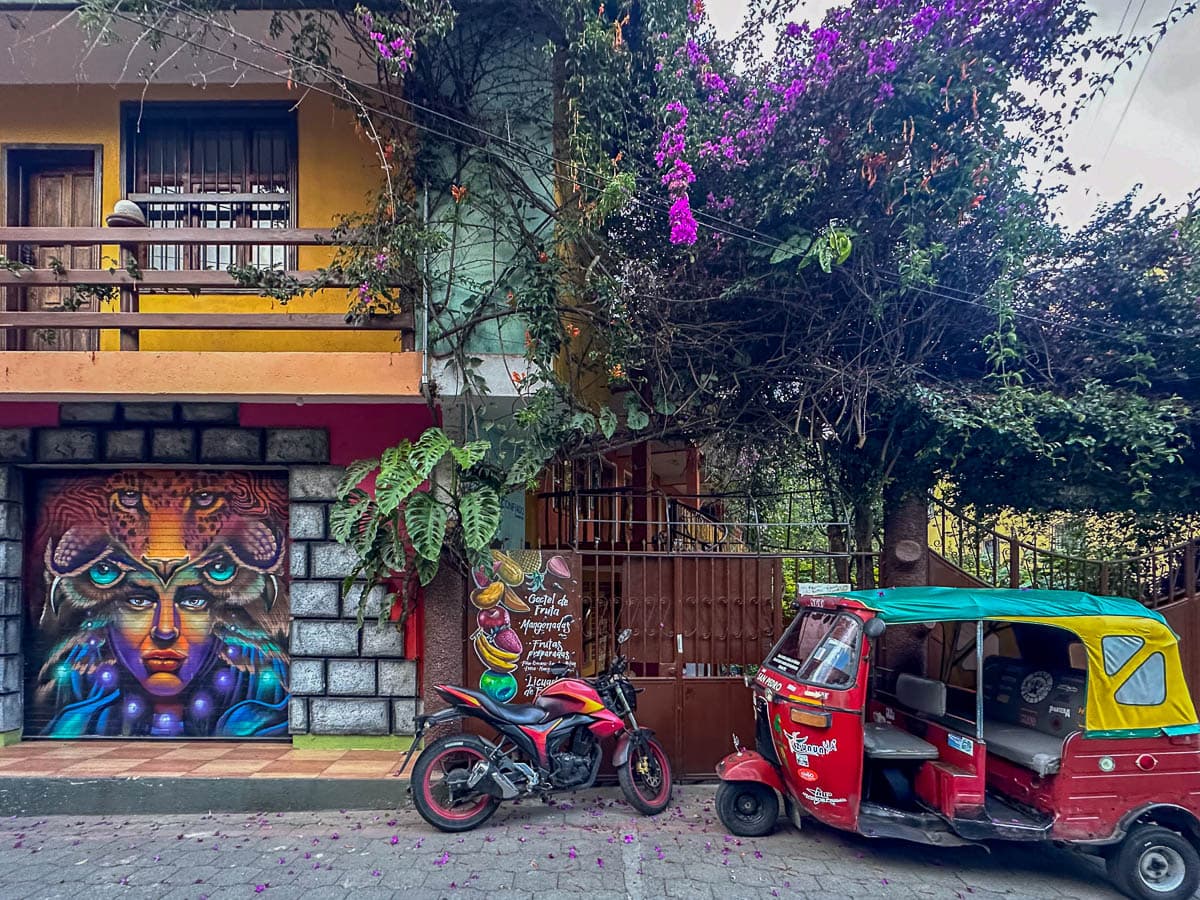
And while there’s plenty of taxi drivers at the airport, some of them in Guatemala aren’t safe for visitors—e,g, avoid white cabs, which are privately operated and have been known to be associated with criminal activity.
Rental car
If you’re a REAL confident driver, want as much flexibility as possible, and are planning on visiting other areas of Guatemala besides Lake Atitlan, you could consider renting a car.
To be honest, I wouldn’t really recommend doing this—drivers in Guatemala are a bit chaotic, especially in cities, the roads to Lake Atitlan are narrow and windy, and you’d have to leave your car in Panajachel to get to San Pedro. Plus, getting around Guatemala with shuttles is affordable and easy.
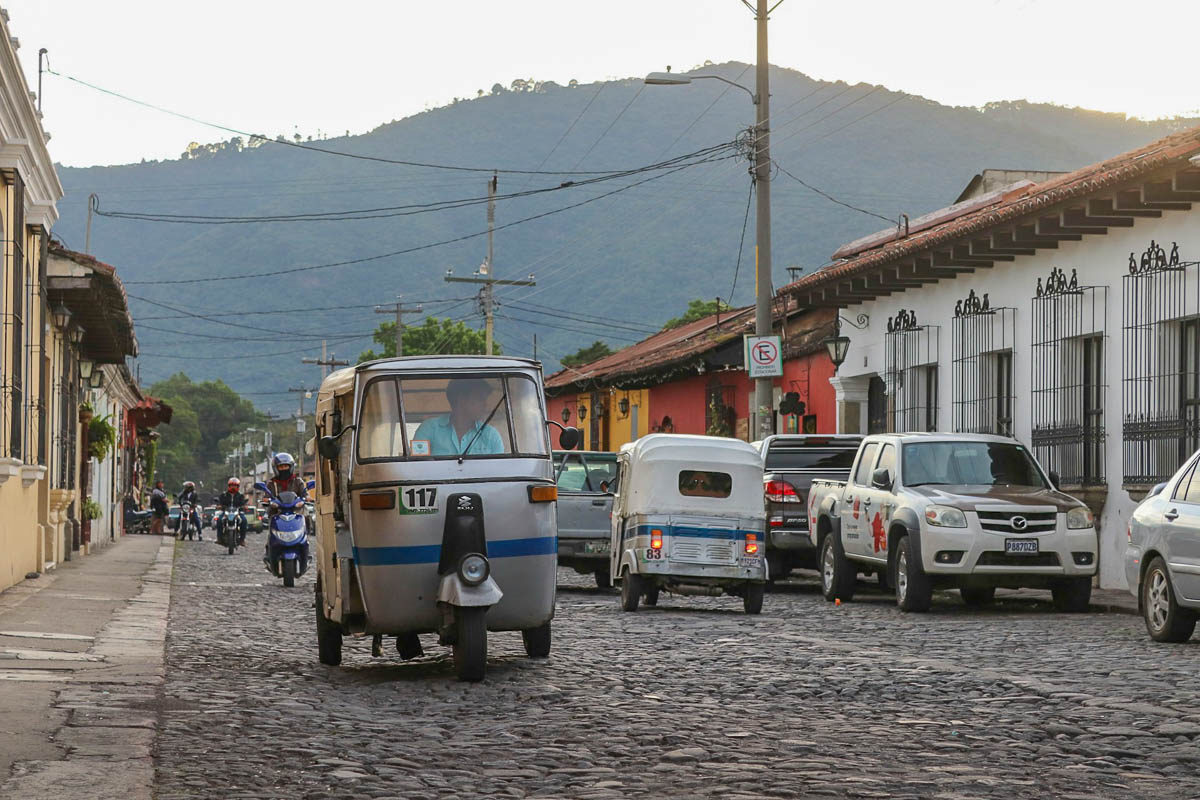
But, if you value complete flexibility and autonomy, it’s definitely an option!
Getting from Panajachel to San Pedro
Most shuttles will drop you off near the Selina Hostel in Panajachel, just down the street from the town’s public dock. As you walk to the dock, there will be tons of people asking if you need a ride on a tuk-tuk or on a boat—just say “no, thank you” and head straight to the dock.
Once you’re here, one of the guys working on the lanchas will ask which town you’re headed to and will direct you to the appropriate boat.
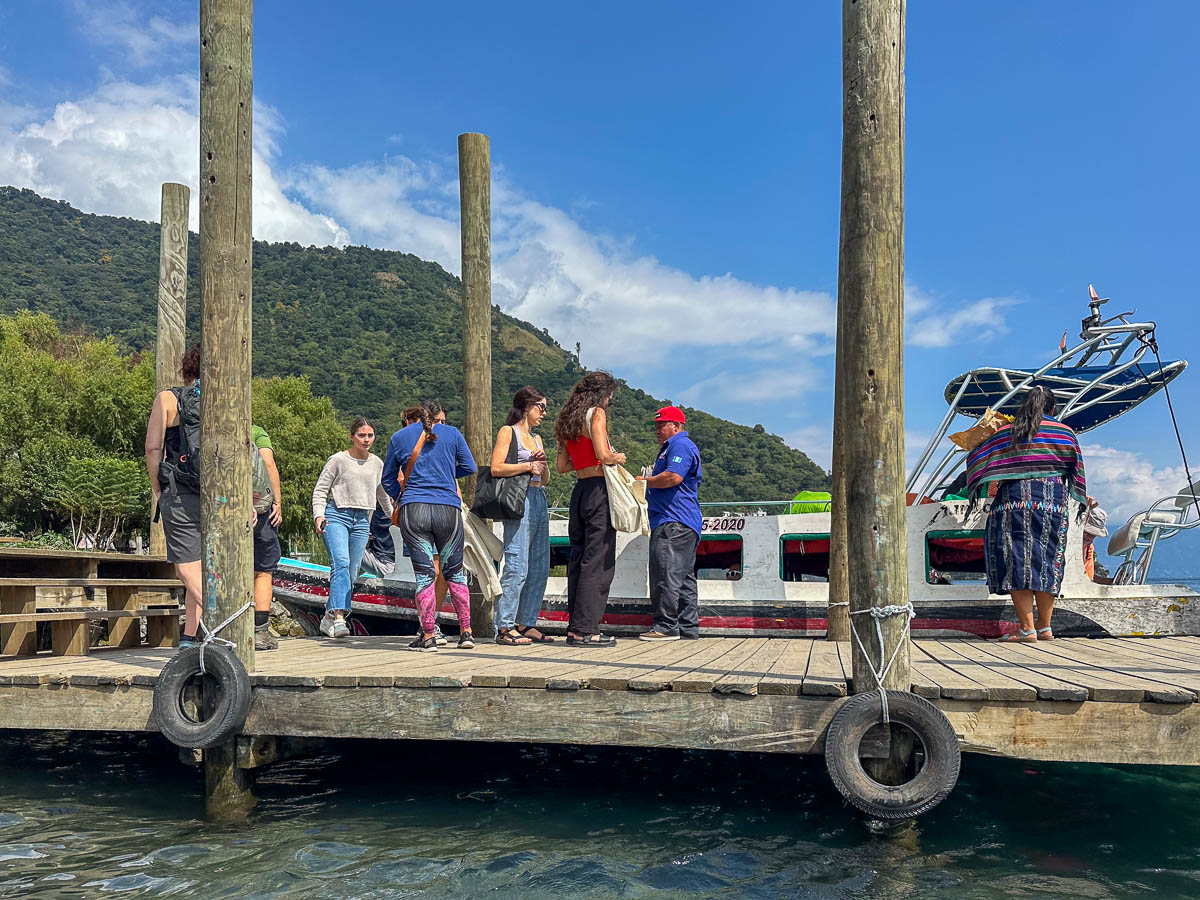
I’d recommend asking before you get on how much it will cost to go from Panajachel to San Pedro—it shouldn’t cost more than 30Q. There are some public boats (which charge 25Q for the trip), as well as private boats, who tend to charge more. Truth be told, I haven’t figured out how to tell these boats apart, so it’s best to just ask beforehand than be surprised when you’re getting off the boat.
Boat service runs between 6:30 AM and 7:30 PM, with boats leaving every 15 minutes or so (or, realistically, when they fill up). It’s important for you to plan your travels so that you arrive in Panajachel when the boats are operating—otherwise, you’ll just need to stay in Pana for the night and catch a boat to San Pedro the following morning.
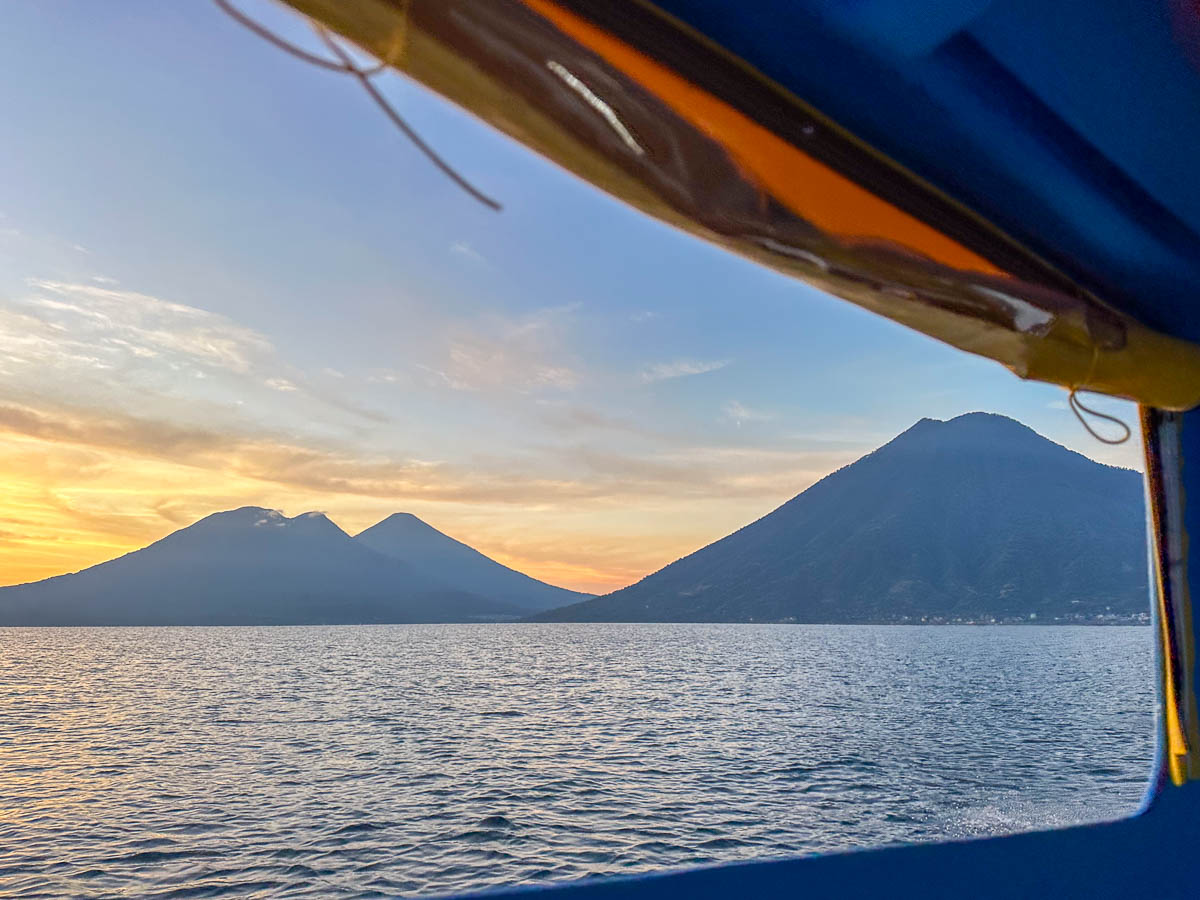
Insider tip: If you have a larger bag, the guys will put your luggage on top of the boat and typically do not strap it down or cover it with a tarp. I’ve never seen or heard of a bag falling off the boat (which is kind of amazing!) , but I have heard of bags getting drenched, especially if it’s raining or the waves are particularly high.
Accordingly, I’d recommend taking out any electronics, valuables, or other things you don’t want to get wet, like your passport, and stowing those away in a smaller, personal bag that you keep on your person during the boat ride.
What to Do in San Pedro, Guatemala
San Pedro is mostly known for its loud bars and cheap beer, but there’s SO much more cool stuff to do than that!
1. Hike up Indian Nose
Indian Nose is one of the most iconic hikes in Guatemala, taking you to the summit of a 9,393 foot mountain that offers spectacular views of Lake Atitlan below and the charming towns that are perched on its shores. It’s most commonly hiked for sunrise, where you can see the first rays of the sun peek over the volcanoes that ring the lake.
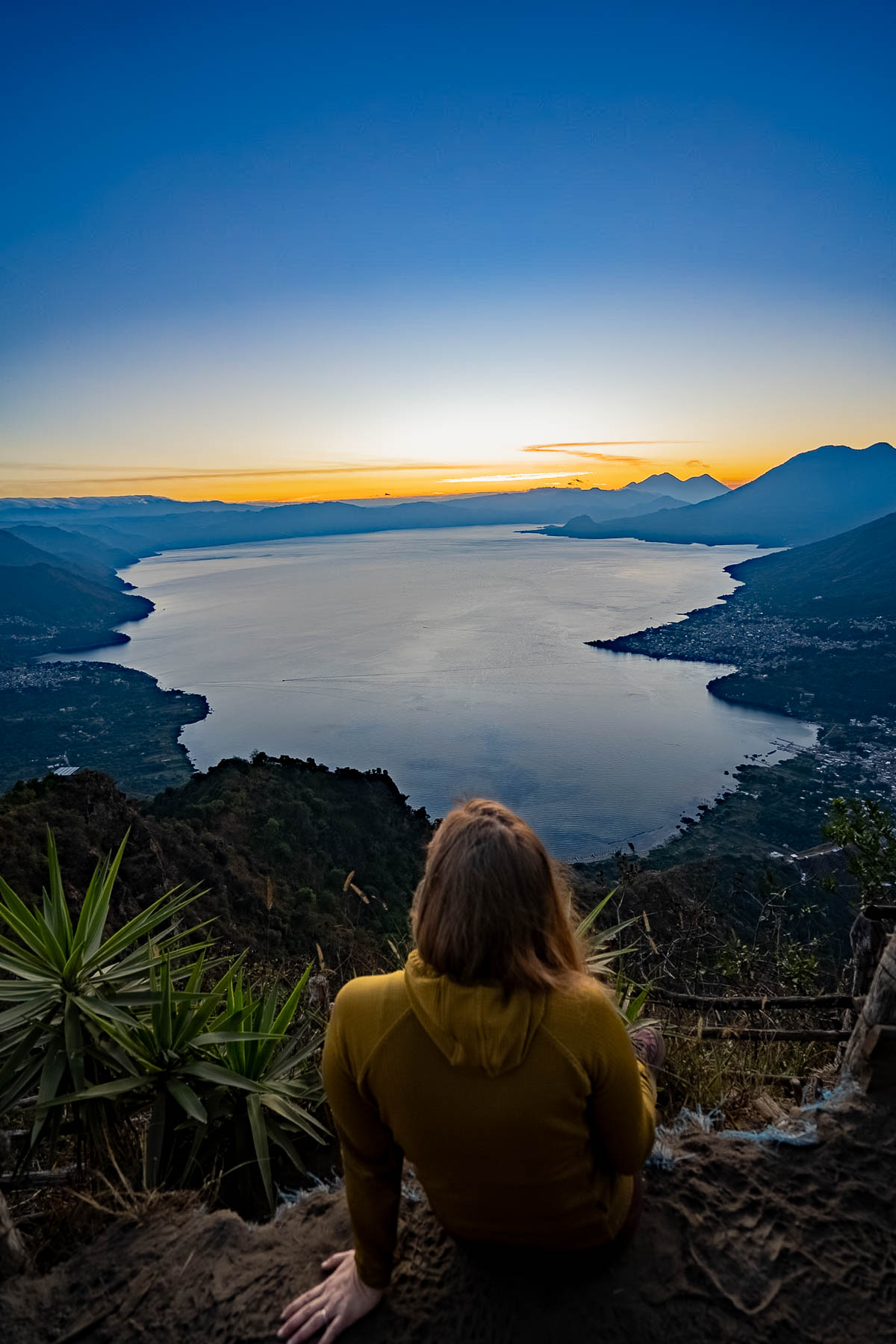
Indian Nose itself isn’t in San Pedro—it’s actually situated between the towns of Santa Clara and San Marcos and has a trailhead in San Juan (a town that’s within walking distance of San Pedro) or Santa Clara.
Most travelers hike this trail as part of a tour, like this group option, this group option, or this private option, and from the trailhead in Santa Clara, given it’s safer and not quite as challenging as the trail from San Juan.
Other than the safety concerns, you frankly don’t need a guide to hike this trail, but the guides do typically give you a sweet pastry and coffee or hot chocolate at the summit as you watch sunrise—definitely a great way to start the day!
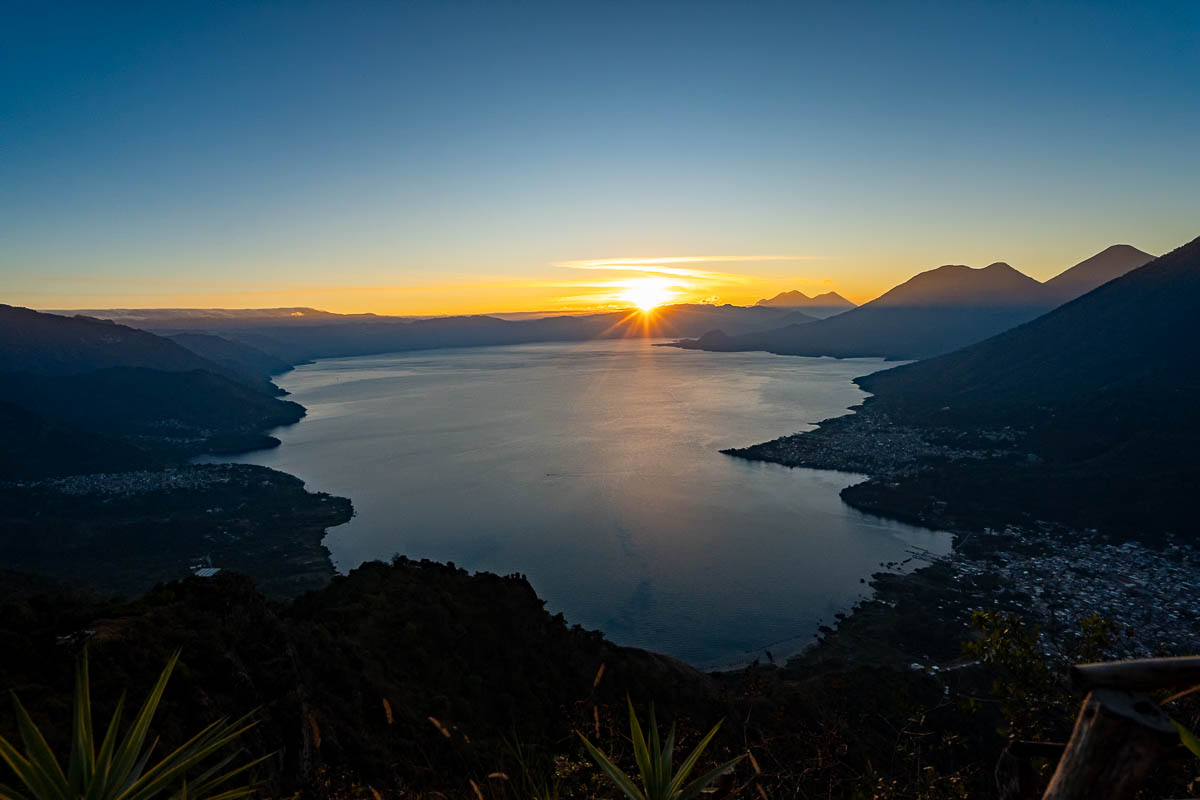
Due to the challenges of getting around Lake Atitlan and how early you need to start the hike for sunrise, these tours are basically only offered from San Pedro or San Marcos—in fact, we actually stayed in San Pedro during our first visit, solely because it was the best spot to join a sunrise tour up to Indian Nose!
2. Relax at Los Termales
One of my favorite things to do in San Pedro is a bit of a hidden gem and will be perfect after your hike to Indian Nose—enjoying the pools at Los Termales!
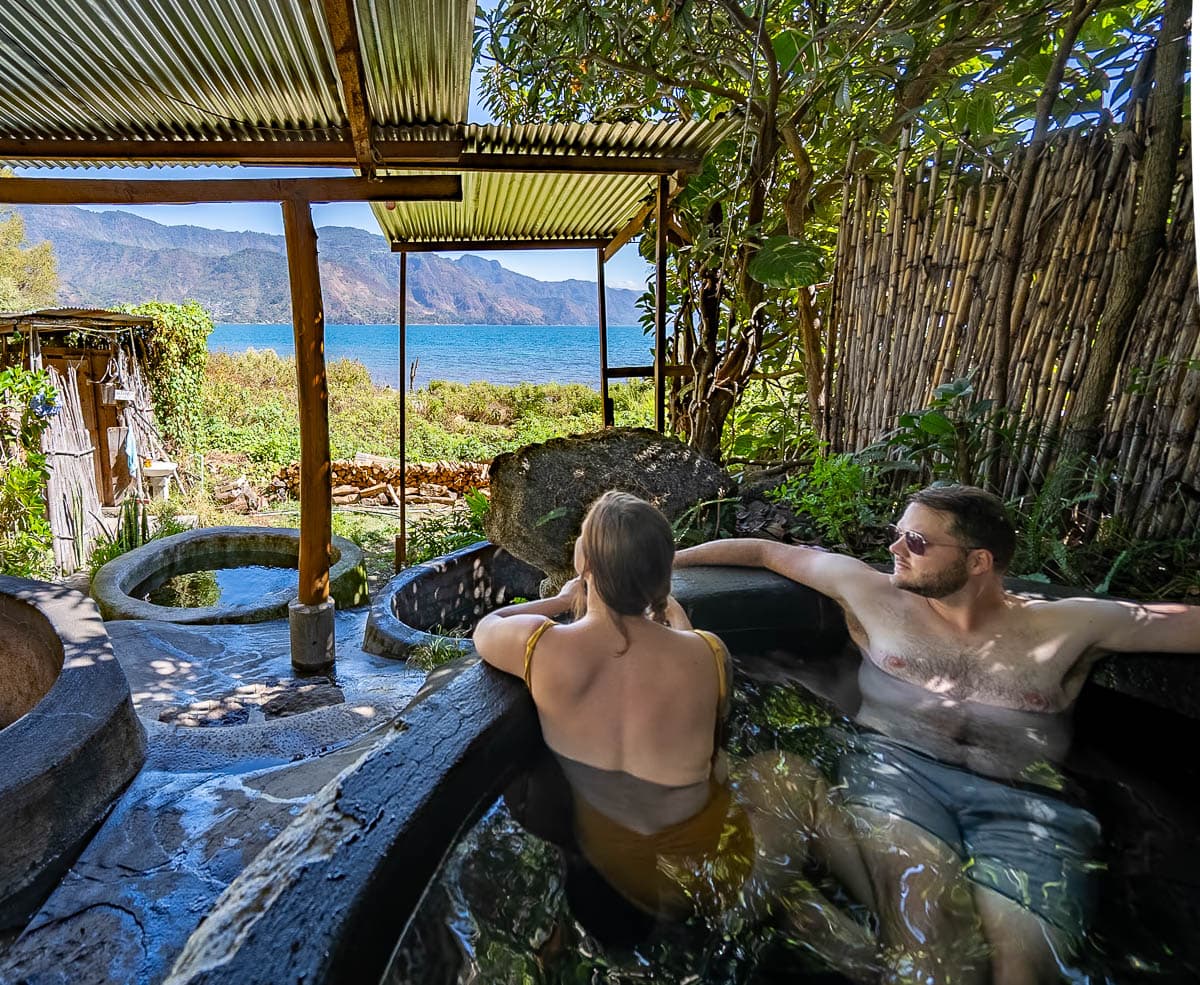
Los Termales is a business that offers massages, saunas, and, best of all, a series of hot and cold pools that offer stunning views of Lake Atitlan. The rates are quite affordable—when we visited, an hour massage, plus an hour to enjoy the hot pools cost around $30 USD.
Just as a word to the wise, you do get your own private hot pool at Los Termales, but you may need to share the pool area with other visitors. When we visited, there was another traveler, soaking in one of the pools, who was a lethal combination of quite chatty AND a Negative Nancy, which made the experience slightly less relaxing than it otherwise would be. So, if you want to enjoy the pools by yourself, I’d suggest getting to Los Termales early!
3. Learn Spanish
One of the things that Lake Atitlan is most famous for is its Spanish schools, which are sprinkled through the towns that ring its shores. These schools are excellent for improving your Spanish skills, whether you only know “gracias” or consider yourself a fluent speaker.
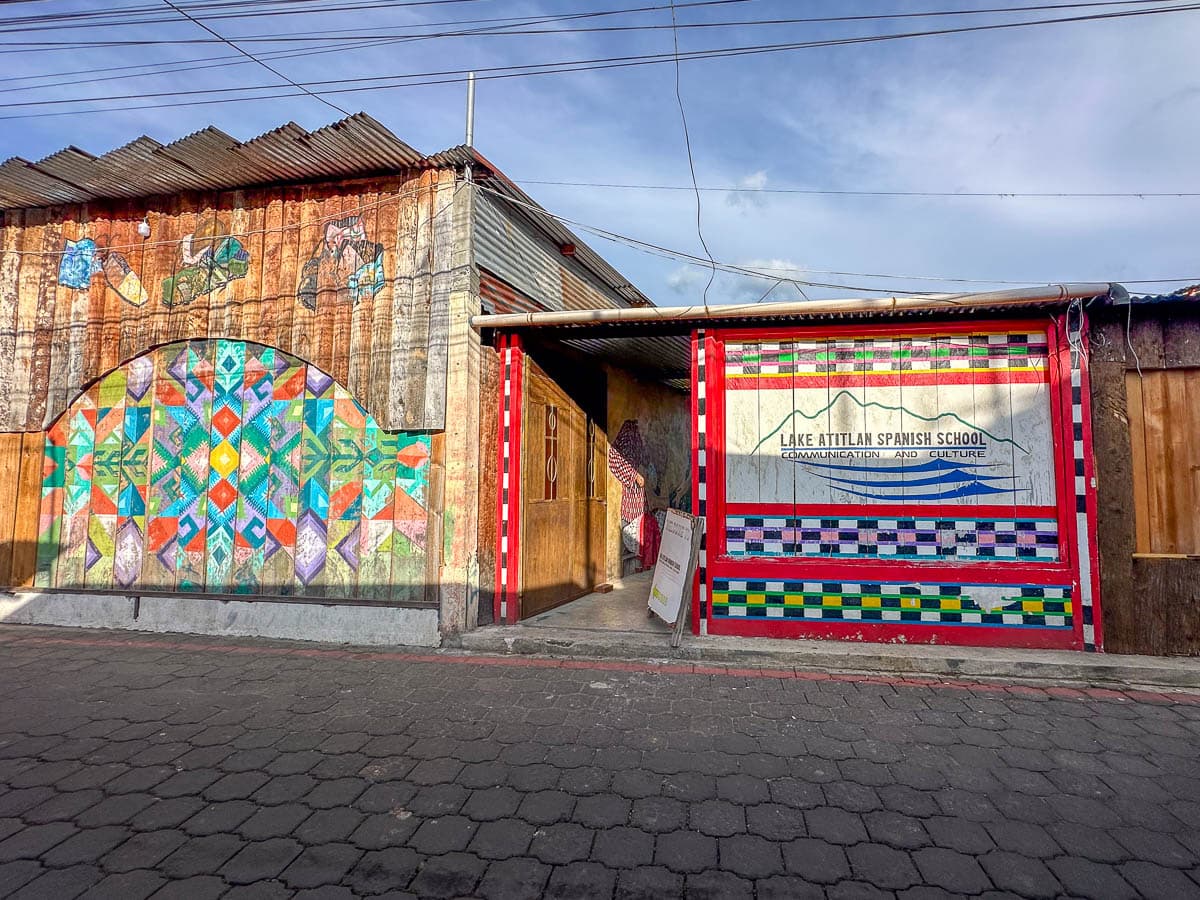
Guatemala is an awesome place to attend Spanish school—not only is it incredibly affordable (as little as $24 USD for three hours of classes with your own private tutor), but Guatemala is known as one of the best countries in the world to learn Spanish, given Guatemalans are known for having a more neutral accent and for speaking slowly. Plus, if you go to Spanish school in San Pedro, you’ll be able to spend the time you aren’t in Spanish school out and exploring this incredible area!
Justin and I spent two weeks at the Lake Atitlan Spanish School in San Pedro, studying for four hours a day and staying with a Guatemalan family, before we embarked on a seven month trip around South America. Before our time at the school, we had only studied Spanish with Duolingo, so we didn’t have any experience speaking with or listening to others speak Spanish.
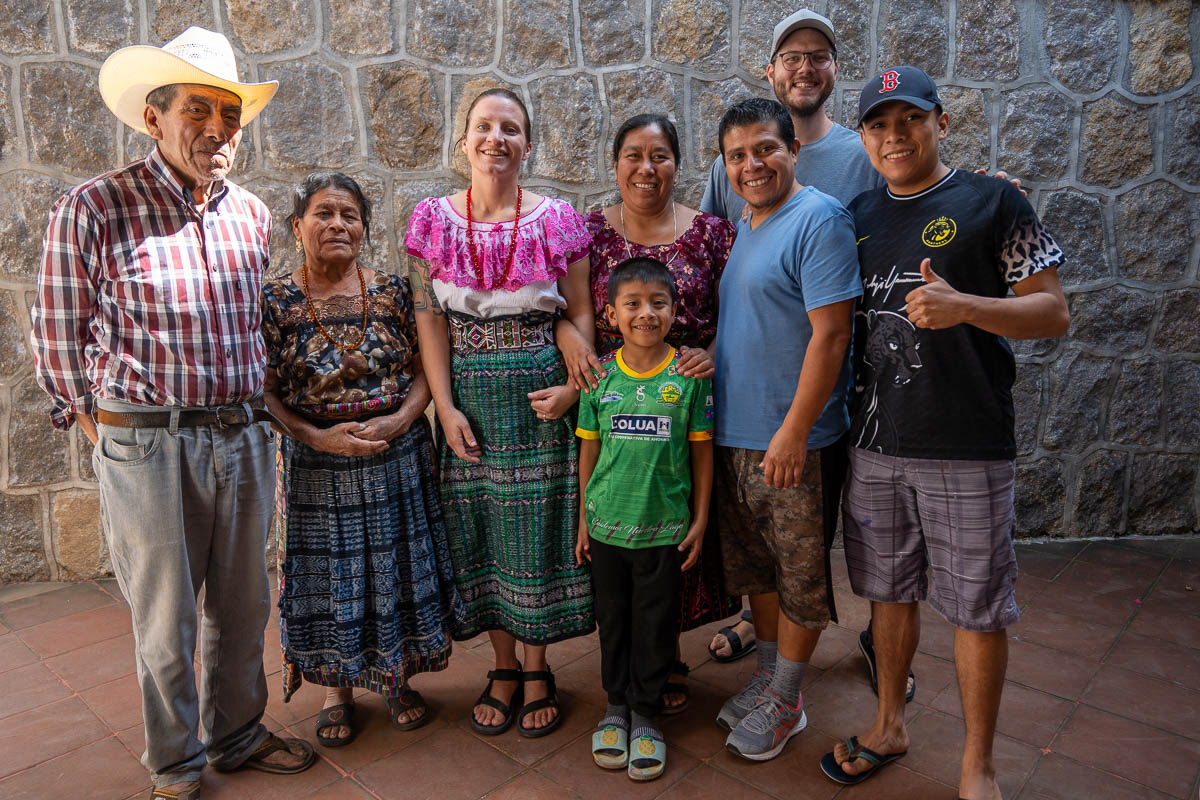
To be honest, we magically didn’t become fluent during our two weeks of Spanish school, but we did feel MUCH more confident with speaking Spanish for our travels around South America!
Plus, we had a wonderful experience with our homestay family, who were super sweet and treated us as one of their own! Like many residents of San Pedro, our home stay family is Mayan, so we got to learn a ton about Mayan culture, from learning a few words in the language to trying traditional foods.
4. Hike the San Pedro Volcano
If Indian Nose wasn’t enough of a challenge for you, climb the San Pedro Volcano, which towers next to the town at 9,908 feet tall.
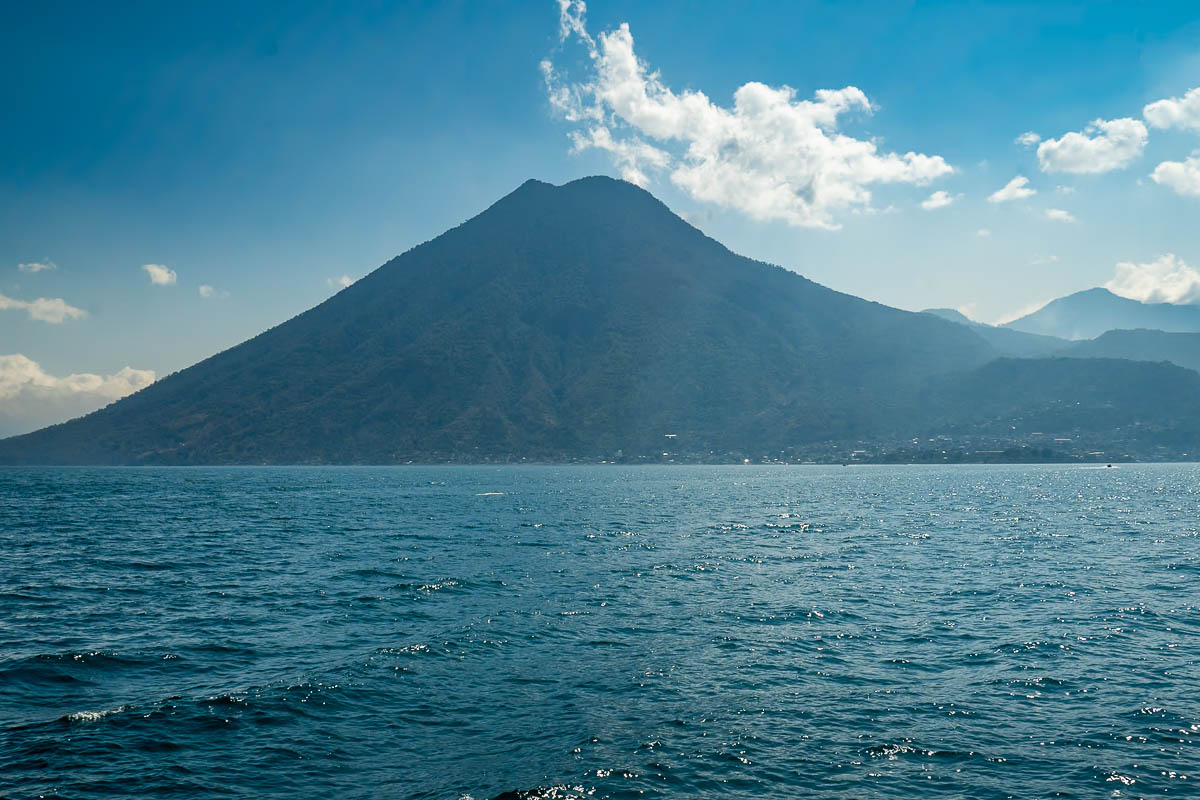
This hike is DEFINITELY a butt-kicker—in less than two and a half miles, you’ll ascend a whopping 3,815 feet (so over 1,500 feet per mile—yikes!). Still, if you make it to the top, you’ll be rewarded with a jaw-dropping view of the surrounding mountains, volcanoes, and the lake below.
It’s easy enough to get to the trailhead by taking a tuk tuk from town, but I’d strongly recommend booking a tour from one of the countless agencies lining San Pedro’s streets. Recently, there’s been a string of armed robberies along the trail and, while guides aren’t immune to crime, they usually deter criminals from targeting tourists.
5. Have a pool day at the Sababa Resort
One of the most seriously underrated things to do in San Pedro is to get a day pass at the Sababa Resort.
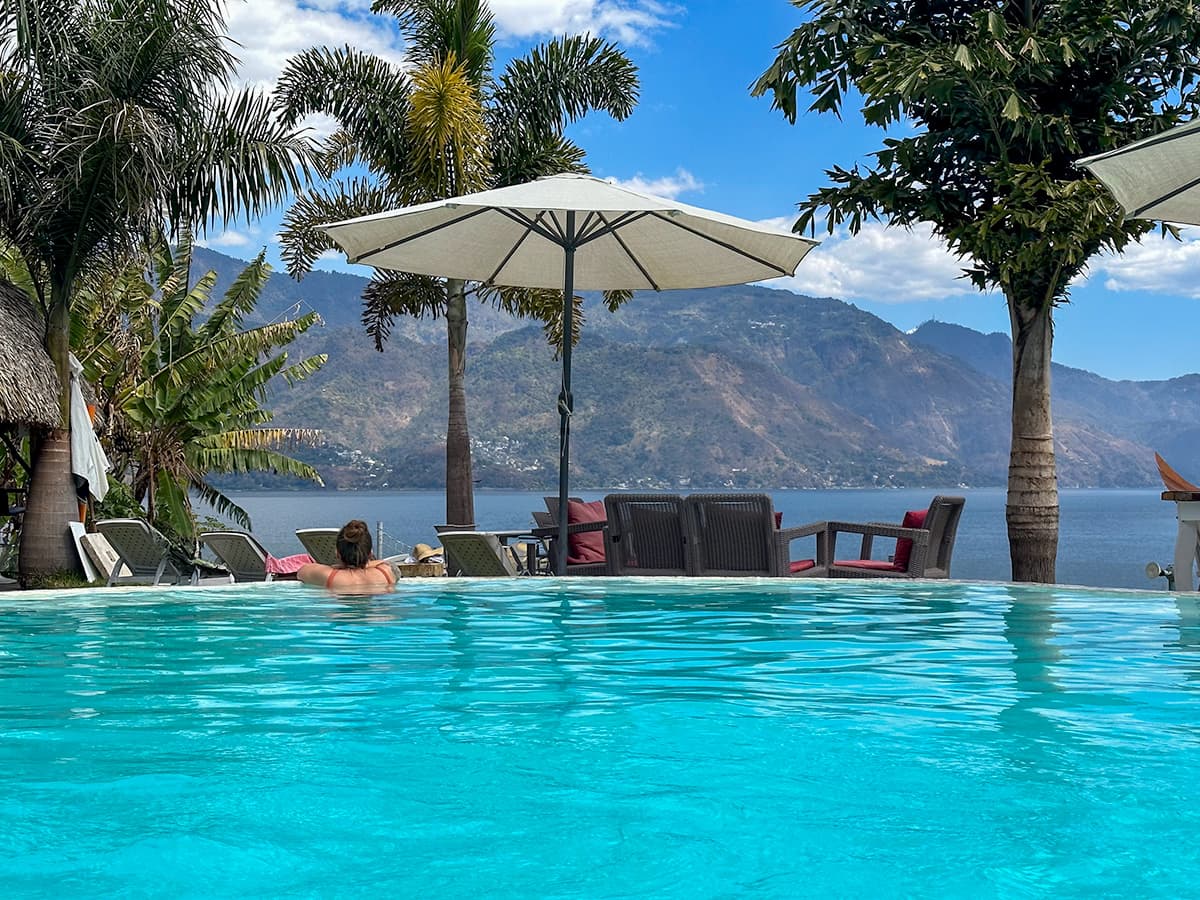
For 50Q (or about $6.50 USD), you’ll get access for the day to Sababa’s very Instagrammable pool, which overlooks Lake Atitlan and the lounge chairs surrounding it, plus poolside service to boot. Justin and I don’t get a lot of time to just *chill*, so spending a day by the pool at Sababa was one of the highlights of staying in San Pedro for me!
6. Paddle around Lake Atitlan in a SUP or a kayak
Getting out on the water can be one of the best ways to enjoy the beautiful views of Lake Atitlan and its surrounding villages and to cool off from the hot Guatemalan sun.
If you’ve already had some experience paddling, there’s lots of rental places to choose from, like Kayaks & Paddle Board Hito or San Pedro Paddle.
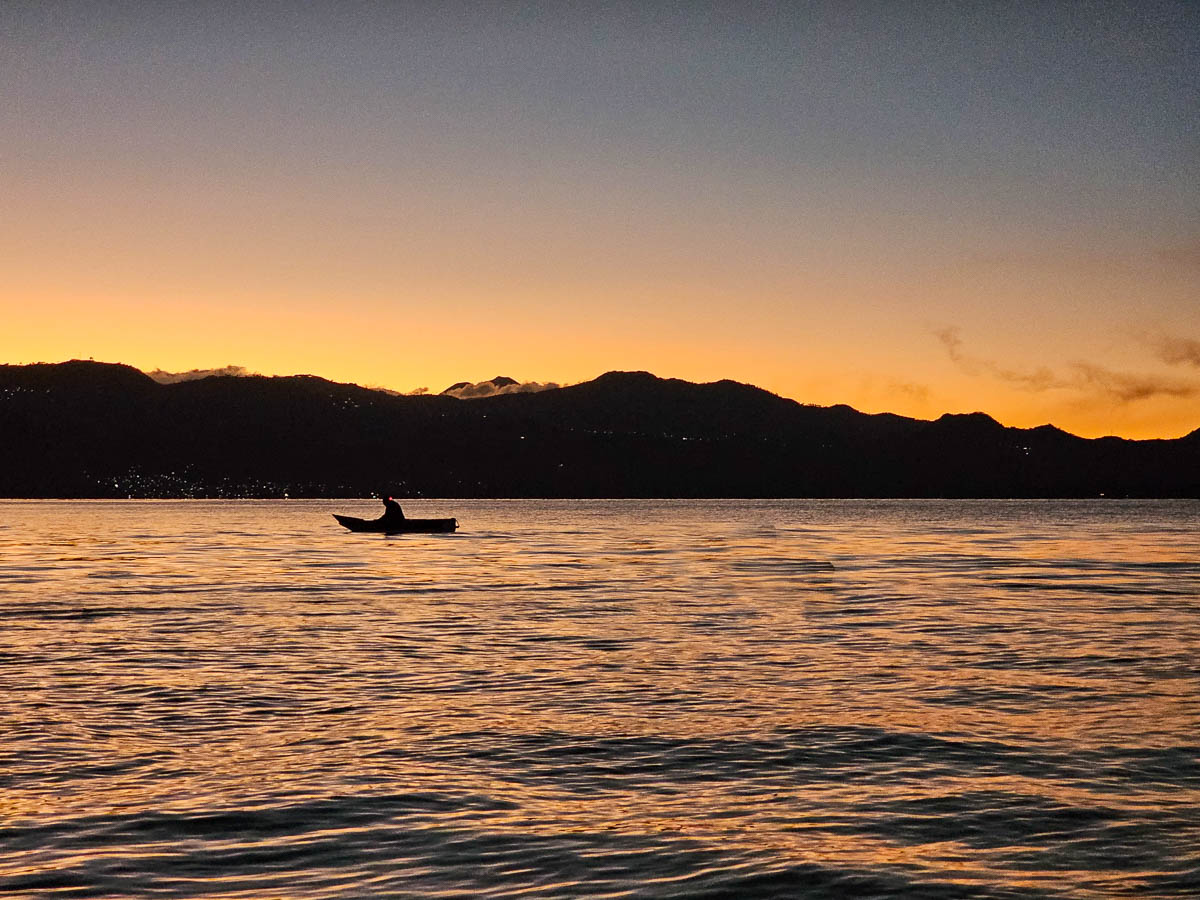
If you’re a beginner, I’d recommend joining a tour, like this option, instead of heading out on your own. In full transparency, Guatemala is not exactly known for its rigorous safety practices, like providing life jackets or ensuring equipment is in good working order, and it’s much better to have a knowledgeable guide with you than just being out in the lake (which is up to 1,100 feet deep!) by yourself.
7. Visiting the surrounding Mayan villages
Okay, this is kinda cheating, but one of the best things to do in Lake Atitlan is to explore the towns dotting its shores, in addition to your homebase in San Pedro.
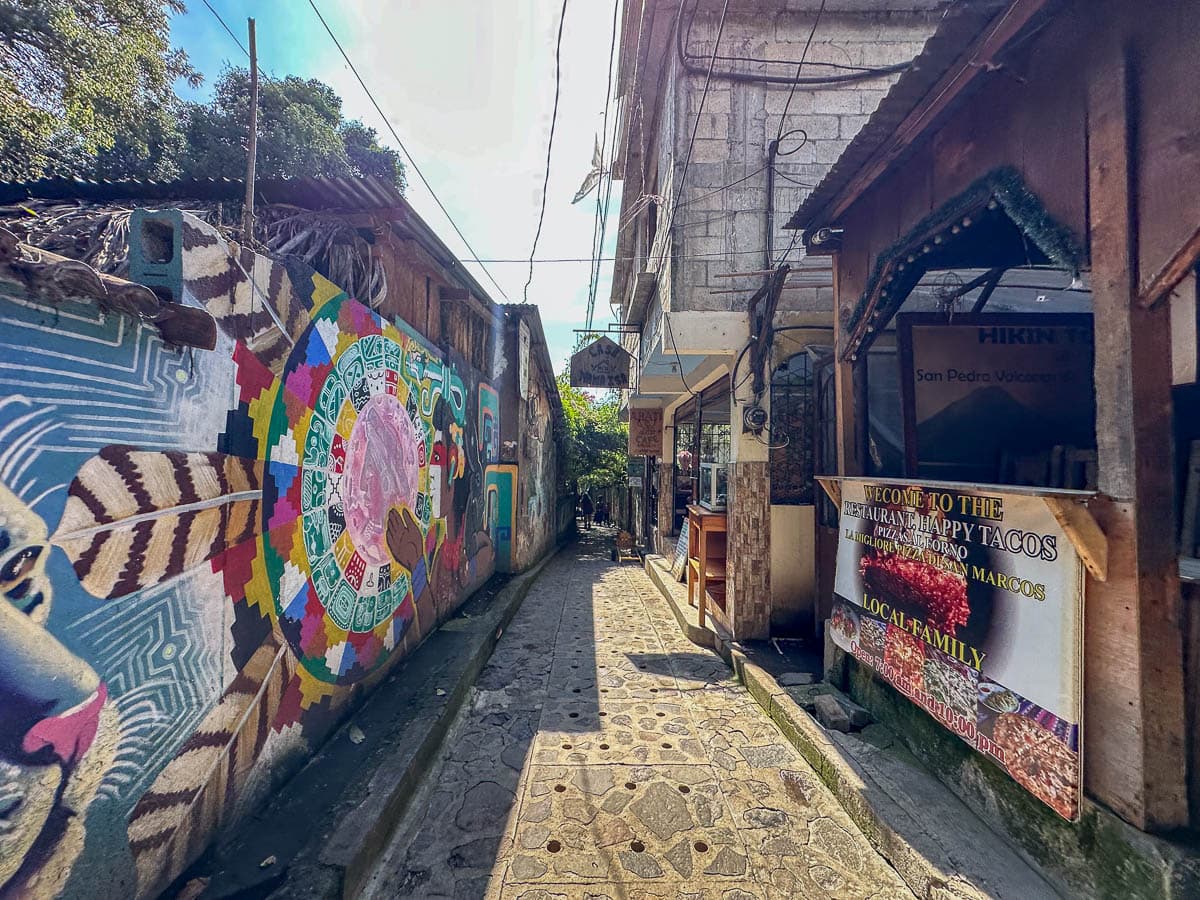
It’s super easy and affordable to get around to the other towns, using the same lancha system that you took from Panajachel. Lancha rides to other towns typically cost 15Q to 30Q one way. If you’re staying in San Pedro, though, just make sure to ask at the town’s docks when the last boat back is—some of them stop operating as early as 5 PM, so you don’t want to accidentally get stuck in a random town!
Here’s a few of my favorite towns in Lake Atitlan:
San Juan
This small, colorful town is right next to San Pedro and only a 20 or so minute walk from the downtown area. San Juan is great if you’re interested in learning about or purchasing Mayan weavings or if you want to see some of the lush plantations in the area, like on this coffee farm tour.
San Marcos
San Marcos is known as the “hippie” town of Lake Atitlan, with lots of places offering reiki healing, guided meditations, and yoga classes.
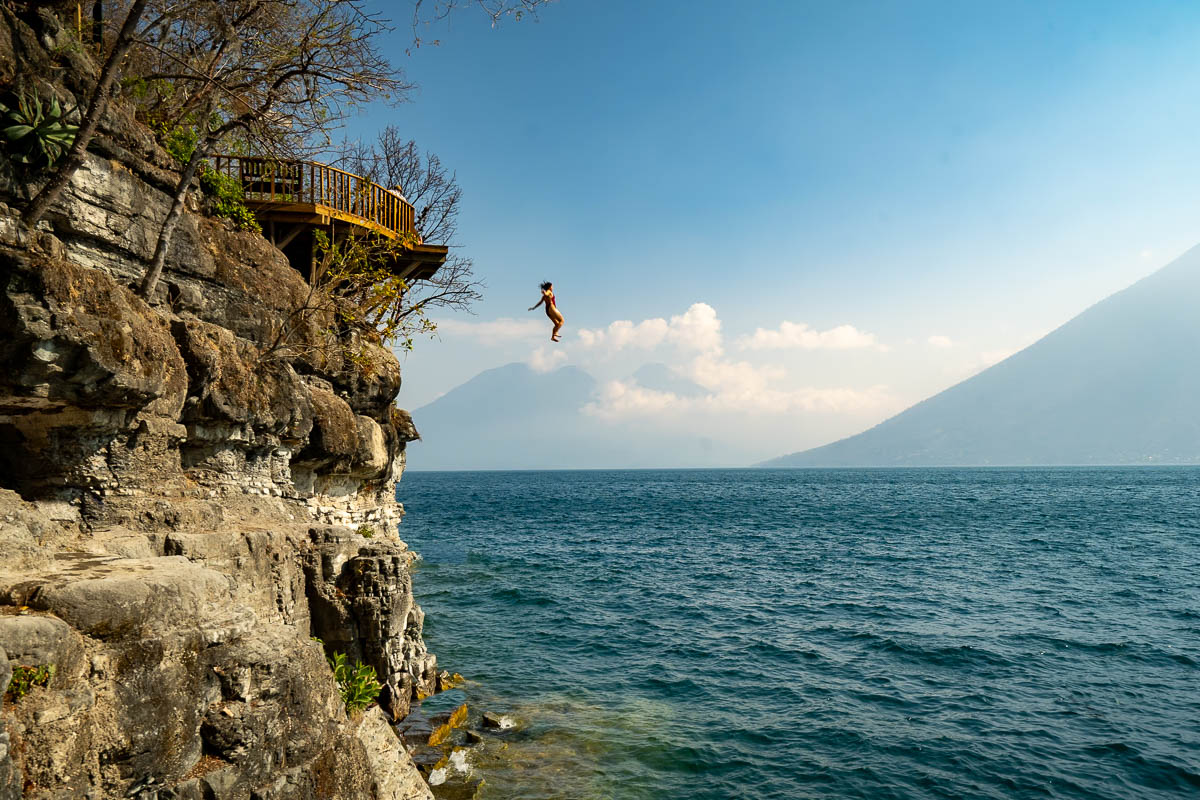
For example, I’ve had an AMAZING experience attending a yoga class and a Mayan chocolate ceremony at the Eagle’s Nest, an ecolodge/yoga studio that’s tucked high into the mountains of San Marcos with insane views. Another popular attraction here is Reserva Natural Cerro Tzankujil, a nature reserve with some short hiking trails and several diving platforms for cliff jumping into the lake.
Panajachel
To be honest, Pana isn’t really my favorite town in Lake Atitlan—it’s much more crowded, dirty, and commercialized than the other towns we’ve explored.
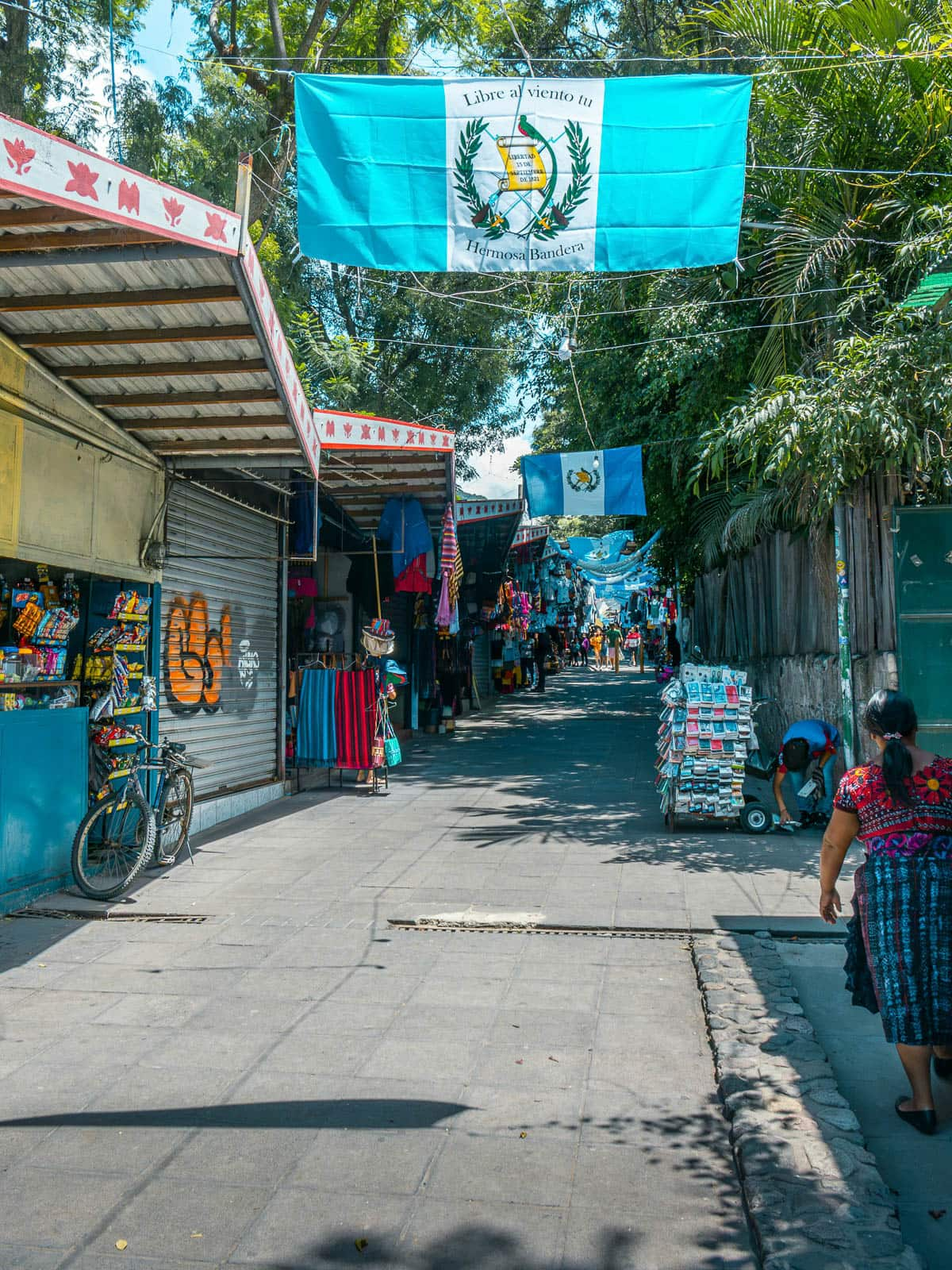
That being said, given how accessible it is, it DEFINITELY has the widest variety of bars, restaurants, shops, and things to do, ranging from ATV tours and attending Mayan ceremonies to karaoke nights and learning how to cook traditional Mayan food.
Santa Catarina Palopo
The most underrated town in Lake Atitlan, in my opinion, is Santa Catarina Palopo, a tiny town on the north side of Lake Atitlan, with natural hot springs along the lake shore, beautiful viewpoints, and a colorful downtown area.
Where to Stay in San Pedro, Guatemala
There’s TONS of accommodations to choose from in San Pedro, from budget hostels to luxury resorts. Here’s some of the best places to stay:
Amigos
Amigos is a hostel, located in the heart of San Pedro, but generally manages to be a chill respite from the bars and restaurants blaring music, right outside its doors.
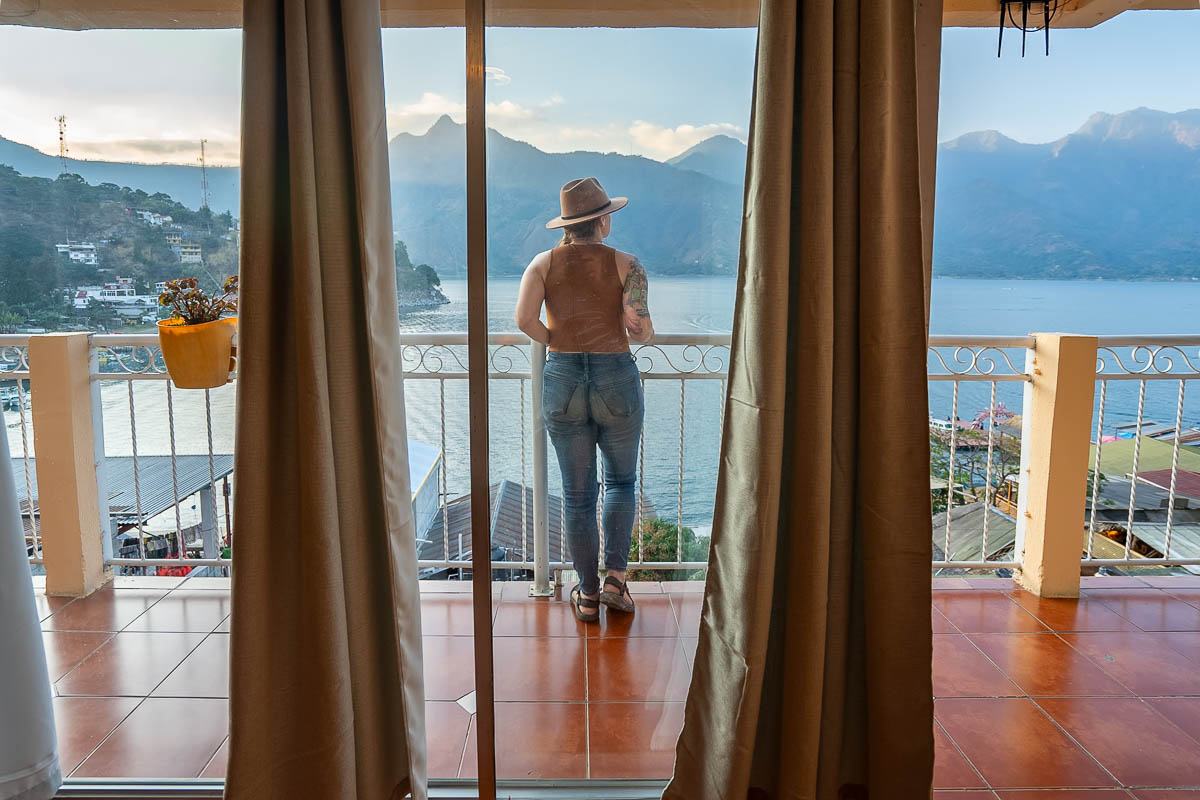
There’s a wide variety of rooms, from mixed dorms to private suites; complimentary breakfast for guests that book online; daily yoga classes; and a shared rooftop terrace with some of the best views of Lake Atitlan.
Justin and I have stayed here both times we’ve been in Lake Atitlan in a private suite with stunning views of the lake and the surrounding mountains—so, obviously, we really love this place!
Mikaso Hotel
Mikaso is located on the outskirts of San Pedro, so you’ll be away from all of the loud music, but within walking distance to all of the action.
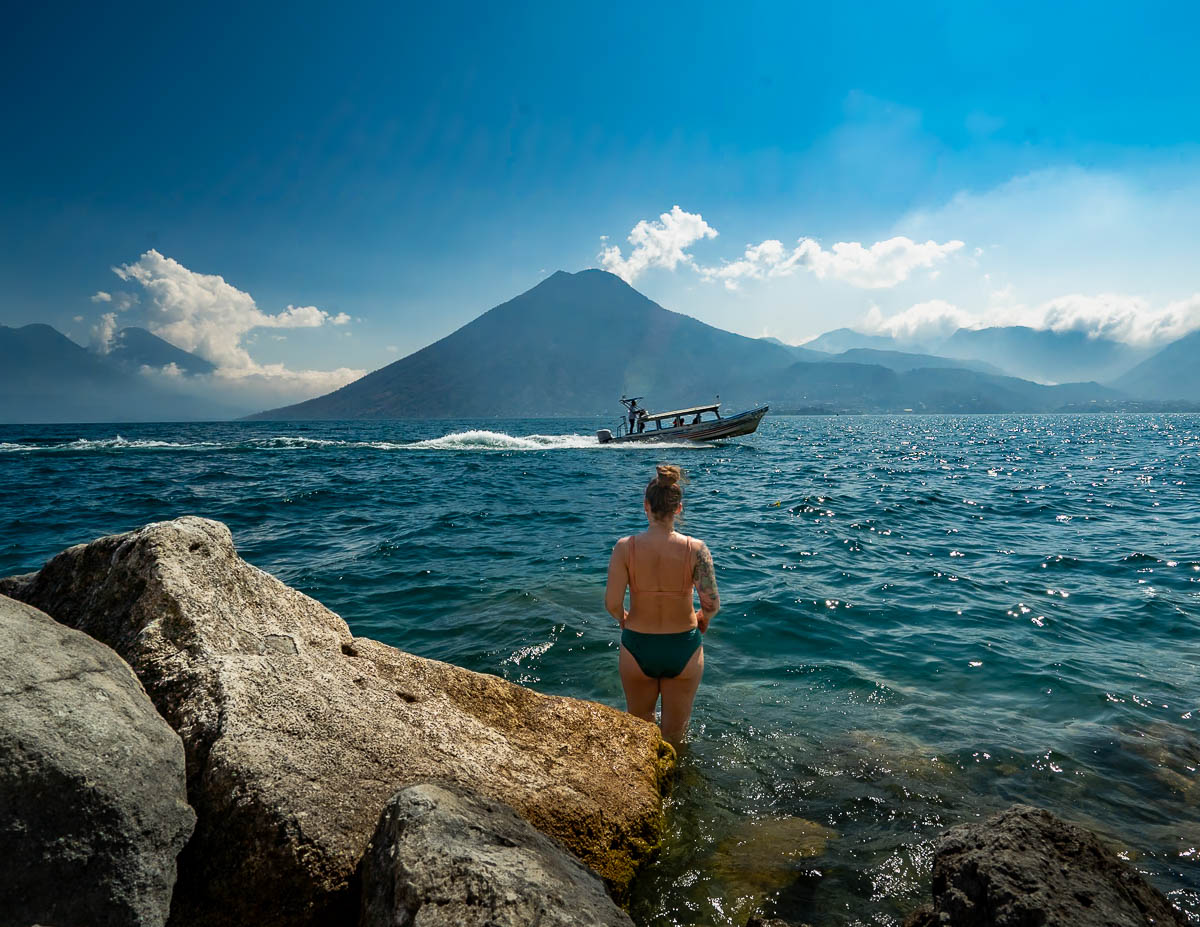
This hotel is right on the shore’s of Atitlan, with spectacular views from its huge windows, and even has a small beach and a dock that you can swim from. The rooms are definitely on the basic side, but have everything you need and the staff here are extremely warm and helpful.
Casa Lobo
Instead of the standard backpacker hostels that you’ll find around most of Lake Atitlan, Casa Lobo has adorable little bungalows, tucked in the mountains outside of the town. The bungalows have a sauna and an EPIC infinity pool overlooking Lake Atitlan, with some units offering fully equipped kitchens and terraces. Plus, the property often schedules fun activities, like salsa classes!
Pssst... if you want to just relax for a few days around Lake Atitlan, consider staying at the Instagram-famous La Casa del Mundo, which is built into a cliffside and overlooking the lake, in the nearby town of Jaibilito.
Justin and I stayed here to celebrate finishing Spanish school. We wrote a whole review of Casa del Mundo, but, in short, we think staying for a night or two at this beautiful and secluded property is perfect after exploring the much more bustling city of San Pedro.
Where to Eat in San Pedro, Guatemala
One of the reasons that I love San Pedro so much is that it has a HUGE variety of restaurants and street vendors to choose from.
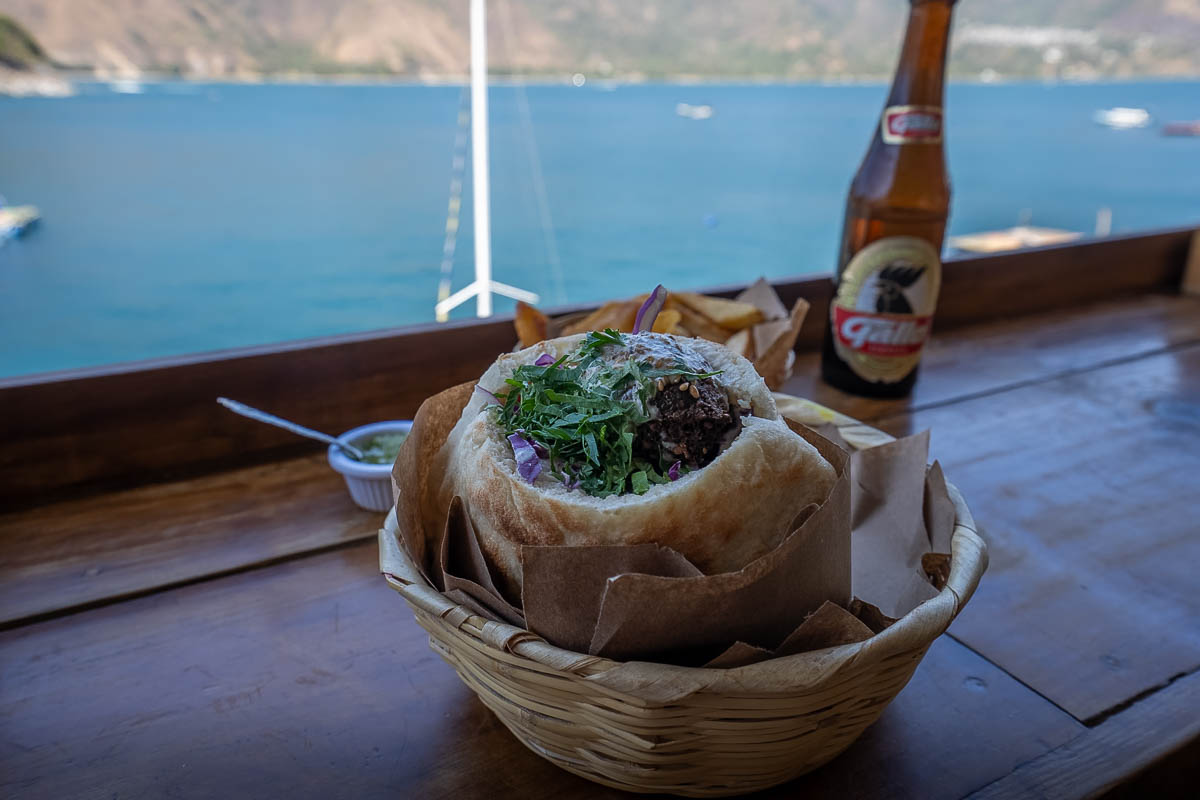
Some of my favorites include:
- Pita Sabij (Middle Eastern, with the best falafel wraps I’ve ever had, anywhere in the world—seriously!)
- Jakuu (traditional Guatemalan)
- Sababa (Israeli and standard Western fare, like sandwiches and soups)
- Salud Pura Vida (vegan/vegetarian food)
- Tornado’s Coffee (okay, okay, this is a coffee shop, not a restaurant, but it’s so darn cute and the owner is lovely!)
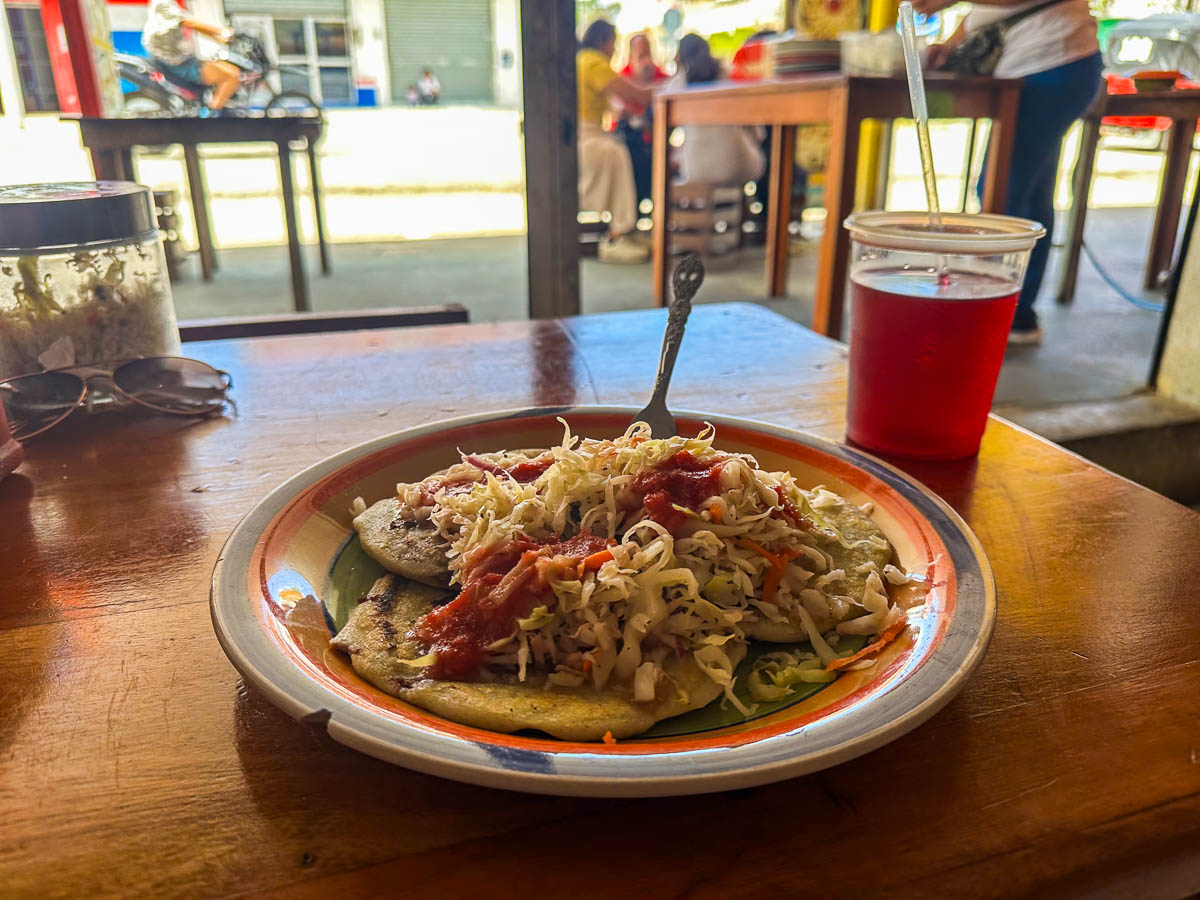
Also, be sure to try some of the street vendors in San Pedro, for dishes like atol blanco, which is a corn-based drink that’s served with beans and chips (it’s very unique!), and papusas, a dish from El Savador that consists of a thick corn tortilla, stuffed with meat, cheese, or beans.
How to Get Around San Pedro, Guatemala
San Pedro is pretty tiny—so, luckily, you can pretty much walk everywhere in town!
One thing to be aware of is that San Pedro is built into the side of a mountain and, thus, is quite hilly.
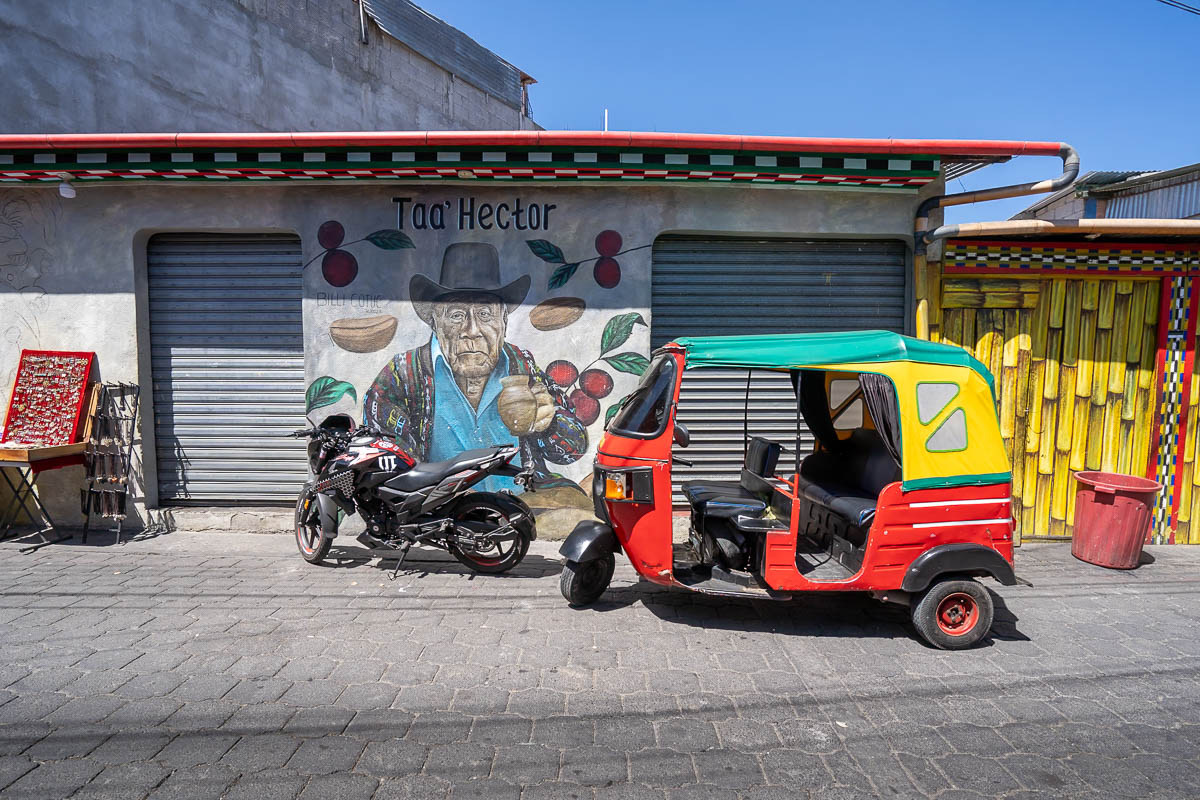
Accordingly, if you have a lot of heavy luggage, have mobility issues, or simply don’t feel like climbing up a super steep hill, you can flag down a tuk tuk (just like you would with a taxi) and get pretty much anywhere in town for under 20Q (about $2.50 USD). Just make sure to agree to a price with your driver before getting in!
Tuk-tuks generally only drive around during waking hours (from around 7 AM to 11 PM), so if you need to get around town super early or super late, you will probably need to arrange one with your hotel ahead of time.
I hope you enjoy San Pedro as much as we did! Do you have any questions about this tiny little town or Lake Atitlan as a whole? Let us know in the comments below!

